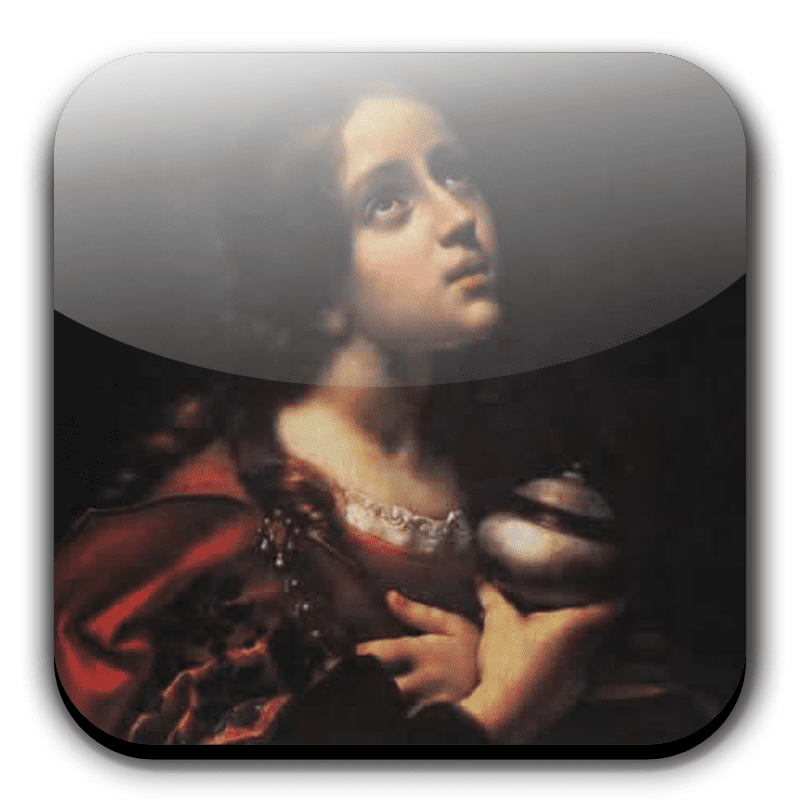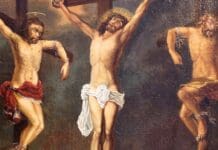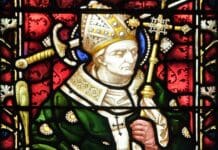St. Mary Magdalene was one of the many “who were assisting them [Jesus and the Twelve] out of their means.” She was present at Our Lords’ Crucifixion, and with Joanna and Mary, the mother of James and Salome, at Jesus’ empty tomb. And, of all the “official” witnesses that might have been chosen for the first awareness of the Resurrection, she was the one to whom that privilege was given. She is known as the “Apostle to the Apostles.”
St. Mary was given the name ‘Magdalen’ because, though a Jewish girl, she lived in a Gentile town called Magdale, in northern Galilee, and her culture and manners were those of a Gentile.
Except for the mother of Jesus, few women are more honored in the Bible than Mary Magdalene. Yet she could well be the patron of the slandered, since there has been a persistent legend in the Church that she is the unnamed sinful woman who anointed the feet of Jesus in Luke 7:36-50.
Most Scripture scholars today point out that there is no scriptural basis for confusing the two women. Mary Magdalene, that is, “of Magdala,” was the one from whom Christ cast out “seven demons” (Luke 8:2)—an indication, at the worst, of extreme demonic possession or, possibly, severe illness.
Father W.J. Harrington, O.P., writing in the New Catholic Commentary, says that “seven demons” “does not mean that Mary had lived an immoral life—a conclusion reached only by means of a mistaken identification with the anonymous woman of Luke 7:36.” Father Edward Mally, S.J., writing in the Jerome Biblical Commentary,agrees that she “is not…the same as the sinner of Luke 7:37, despite the later Western romantic tradition about her.”
According to pious legend, fourteen years after Our Lord’s death, St. Mary was put in a boat by the Jews without sails or oars – along with Sts. Lazarus and Martha, St. Maximin (who baptized her), St. Sidonius (“the man born blind”), her maid Sera, and the body of St. Anne, the mother of the Blessed Virgin. They were sent drifting out to sea and landed on the shores of Southern France, where St. Mary spent the rest of her life as a contemplative in a cave known as Sainte-Baume. She was given the Holy Eucharist daily by angels as her only food, and died when she was 72. St. Mary was transported miraculously, just before she died, to the chapel of St. Maximin, where she received the last sacraments.


















PLEASE CAN U CLEARAFY THIS MORE FOR ME , I UNDERSTAND THERE R 2 MARY’S AND I AM VERY CONF– USED & AM DIEIN TO FIND OUT OK THERE WAS MARY MAGDELENE , THEN THERE WAS ANOTHER MARY WHO WAS RICH, WHEN HER FATHER DIED HE SPIT THE LAND INTO 3 ! MARY , LAZARUS , AND THIER SISTER MARTHA !! HE WAS A KING THE FATHER OF LAZARUS MARTHA & MARY NOW MY QUESTION IS ??? IS THIS MARY MAGDELENE WHO IS THIER SIBLING TO LAZARUS & MARTHA ! I HOPE U UNDERSTAND ME & MY QUESTION ! I AM VERY CONF– USED ON THIS & WOULD LOVE TO HAVE SOME KIND OF DEFINIFION OF THESE 2 MARY’S ! I OWN A MOVIE ” MARY MAGDELENE ” IT IS SUCH A WONDERFUL BUT HEART BREAKING MOVIE & IN THIS MOVIE MARY COMES TO PETERS HO– USE & ANNOINTS JESES FEET W/ HER ALABASTER BOX OF EXPENSIVE OIL TO PREPARE JESUS FOR HIS BURIAL !! PLEASE I LOOK FORWARD TO YOUR ANSWERS FOR ME THANK U SOO MUCH